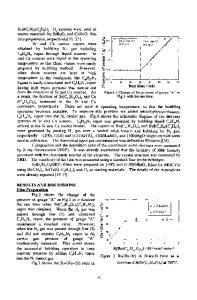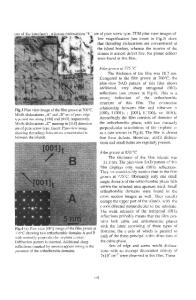Iron Substituted SrRuO 3 Thin Films
- PDF / 558,685 Bytes
- 5 Pages / 612 x 792 pts (letter) Page_size
- 53 Downloads / 340 Views
0962-P10-24
Iron Substituted SrRuO3 Thin Films Aman Ullah1, Young Zo Yoo1, Omar Chmaissem1, Stanislaw Kolesnik1, Bogdan Dabrowski1, and Genis Alan2 1 Institute of NanoScience, Engineering and Technology (INSET), Physics, Northern Illinois University, Dekalb, IL, 60115 2 Institute of NanoScience, Engineering and Technology (INSET), Electrical Engineering, Northern Illinois University, Dekalb, IL, 60115 ABSTRACT Fe-doped SrRuO3 thin films were grown on SrTiO3 (STO) substrates by using the Pulse Laser Deposition (PLD) method. Fe concentrations in the SrRuO3 thin films ranged from 0 % to 11 % to manifest the effect of Fe doping on their microstructure. Lattice constants of the films did not show obvious changes with the Fe doping whereas surface morphologies drastically changed from stepped to island structure with increasing Fe. X-ray reflectivity revealed that the surface and interfacial roughness decreased with increasing concentration of Fe. Surface roughness of the films was confirmed by atomic force microscopy. Therefore, a precise determination of film roughness as well as its growth mechanism using x-ray and AFM is exploited to correlate the Fe doping with structural disorder. INTRODUCTION In recent years, SrRuO3 materials have received considerable attention because of their attractive ferromagnetic properties, structural stability and high room temperature electrical conductivity. SrRuO3 is a ferromagnetic metal oxide with Curie temperature of 163 K. It has a pseudocubic lattice of ~0.393 nm similar to that of common cubic SrTiO3 (~0.391 nm) and other substrates [1]. Therefore, SrRuO3 materials have been seriously considered as potential electrodes in advanced applications. To fully exploit the properties of SrRuO3, the current challenge is to increase its ferromagnetic behavior to room temperature through chemical doping or substitution. In this regard, doping of transition metals in SrRuO3 produces interesting magnetic and electronic properties [2]. In this paper, we report the design and growth of Fe doped SrRuO3 thin films in which doping was achieved during growth using pulsed laser deposition techniques. We found that Fe-doping lead to significant modifications to the growth mode and surface morphology in addition to significantly enhanced magnetization properties (to be published elsewhere). The focus of this paper is to investigate the effects of Fe-doping on the surface/interface roughness and properties as these effects strongly influence the physical properties of the thin films (e.g., magnetic anisotropy, coercivity, magnetoresistance, etc)[3] . EXPERIMENTAL DETAILS Fe doped SrRuO3 films were grown on nominal SrTiO3 substrates (MacTeck GmbH) using the pulsed laser deposition method (PLD) and a KrF excimer laser [248nm, repetition rate 5 Hz]. A base pressure of 3 x 10-7 mTorr was achieved in the chamber prior to deposition. SrRuO3 and Fe2O3 targets were ablated at a laser power of 250mJ during the deposition.
During growth, the pressure and temperature were fixed at 100 mTorr and 750 oC, respecti
Data Loading...











